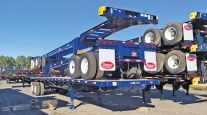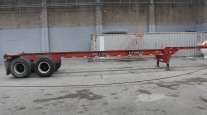Intermodal Chassis Data Systems Improve
This story appears in the July 19 print edition of Transport Topics.
Two computer systems that support new federal chassis safety rules began working together last week, eliminating one of the stumbling blocks in the implementation process.
However, some industry officials reported continued difficulties with the driver vehicle inspection report, or DVIR, that truckers are supposed to use to report defects in chassis provided by ocean carriers, railroads or lessors.
The Federal Motor Carrier Safety Administration’s rules covering intermodal chassis safety took effect on June 30, and widespread problems were reported in the first days after the implementation (7-12, p. 5; click here for previous story).
One of those problems was the inability of computer systems established by the Intermodal Association of North America and the Ocean Carrier Equipment Management Association to exchange data.
IANA Vice President Thomas Malloy told Transport Topics that issue was fixed last week and that “the quality of data flows are excellent because information isn’t being rejected and sent back to the submitter.”
However, Malloy said parts of the process still aren’t working properly because the number of DVIR reports received in the two computer systems falls short of the number of chassis movements made daily in the United States.
OCEMA has estimated the chassis movements at an average of more than 100,000 a day.
“It doesn’t seem like that many DVIRs are being submitted for the amount of equipment that’s out there,” Malloy said, noting that DVIRs presently are being received for between 7% and 12% of chassis moves. “It may be that drivers are saying, ‘Maybe I don’t have to submit one if there aren’t any defects.’ ’’
Rick Todd, president of the South Carolina Trucking Association, told TT that members’ comments about the roadability process range from “it is going reasonably well” to “it is a total waste of time.”
“Like a lot of federal programs, it is being rolled out before the industry is really ready for it,” Todd said. “There have been a lot of glitches.”
Curtis Whalen, executive director of American Trucking Associations’ Intermodal Motor Carriers Conference, said the situation had not changed much in the past week.
“There is still widespread confusion,” he said, when drivers try to submit the reports and ocean carriers often can’t properly process them, so the information can be entered into computer systems.
On the other hand, Whalen said, troubles with the implementation process have not disrupted commerce because drivers are not being turned away from the terminals if they do not have a DVIR.
Neither FMCSA nor Advent Inc., which operates OCEMA’s data reporting system, responded to requests for comment by press time.
“Hopefully, downstream we will get a more proactive maintenance and repair process under way,” Malloy said. “If everybody complies, we will have a solid system, and everything will work as intended.”
The actual incidence of chassis defects isn’t yet known. Whalen estimated the proportion at below 10%, based on anecdotal reports he’s received. OCEMA earlier this year said less than 5% of chassis are defective.
Malloy said IANA is developing a report to measure defects reported electronically, but that information isn’t ready yet.
“Roadability has always been a problem,” SCTA’s Todd said, because drivers who found problems with a chassis before leaving a facility either have to wait for repairs or take extra time hunting down another unit in better condition.
Whalen said he’s concerned that drivers will lose interest in filing the reports because equipment providers often aren’t prepared to accept them.
He said he is telling members to keep careful records whenever a driver submits a DVIR that is not properly processed, so that they are not charged with a violation in any enforcement.




